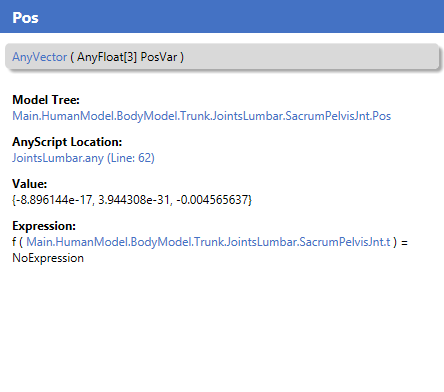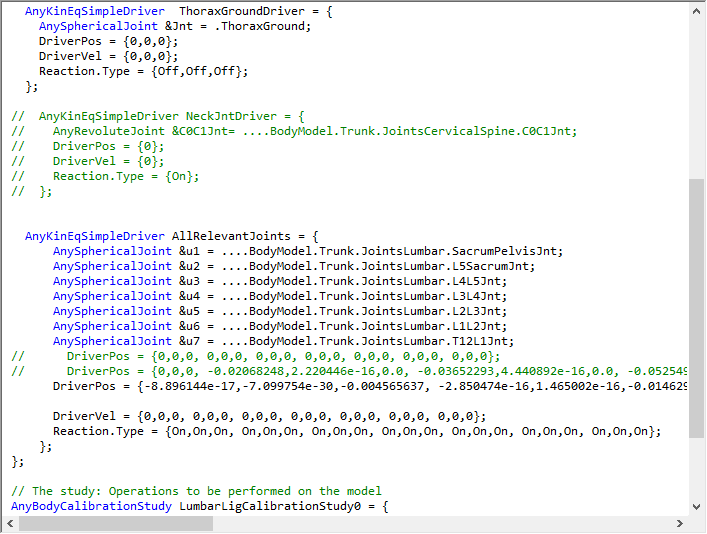When I run the calibration program, does the relaxation length of the ligament automatically correct? Why don't I see any changes in the ligament definition file?
Thank you!
Hi @john1
We have a tutorial about ligaments and their calibration here:
The calibration study will update the slack lengths of each ligament - but you will only be able to see the values in the loaded model. No script file is updated. The calibration study must be performed every time you have loaded a model - prior to running the actual analysis.
Best regards,
Bjørn
Is there any way to let me know the body parameters under the reference position? I want to confirm that the ligament force under the reference position is zero.
Thank you!
What exactly do you mean by the reference position? - the position in which the model is calibrated?
You can extract all the fiber and tendon lengths from the model both prior and after the calibration routine.
You can also find the calibration positions in the calibration study.
Best regards,
Bjørn
Yeah, I seem to have found this value in AnyBody. The value is the same after running the calibration program in all position. However, when I fill in these values into the ligament script, the results that come out of the run are quite unreasonable.
Thank you!
That seem a little odd.
Can you provide an example model where I can test it?
Best regards,
Bjørn
I run the calibration program(RunApplication) and then get the relaxation length of the ligament at this location. (Main.HumanModel.BodyModel.Trunk.LumbarSpineLigaments.L1L2Lig.ALLL1L2.L0].
I would like to know the specific body posture parameters at the calibration position of the model. In the reference position, the force on the ligament should be zero,so that I can verify that the relaxation length is accurate .
Thank you!
You can find the calibration postures inside the calibration study.
There will either be a reference to a series of drivers or the drivers themselves.
The drivers specify the posture to calibrate in.
You can reuse the drivers to run a study placing the model in the same postures and verifying the ligament forces.
Best regards,
Bjørn
I did not find the parameters that I wanted in the calibration study, such as the detailed body parameters in Mannequin file.
Thank you!
Hi Bjorn, you mentioned the calibration posture, could you generally describe what is this posture like? Is this posture similar to standing posture? We tried to calibrate the ligaments at standing posture (example from AMMR V2.3.4 Wilke validation folder) with zero flexion/extension, axial rotation, and lateral bending, somehow the ligament forces after calibration are quite large). May I know why is this? and where can I find the calibrated slack length of the ligaments in the model? I would like to take a close look of them. Thanks!
Qiaoqiao Zhu
Hi @qiaoqiaozhu
The postures are found inside the calibration studies and are used by the drivers inside the study.
There can be small differences between old and new versions of AMS so I suggest just looking at the version you have.
You say you tried to calibrate in a neutral position - yo do this you must have used drivers inside the calibration study with neutral positions. To verify the calibration you can run a subsequent study with similar postures/drivers. It is not enough to position the body through the mannequin file before calibration.
The updated ligament parameters are found through the the model tree inside the ligament classes.
Best regards,
Bjørn
Hi Bjorn,Can you tell the exact path of the reference position setting? Under which sub-file in the calibration file?
Thanks!
Hi @john1
If you enabled the 2-parameter calibration routine then yes, those are the positions.
If you only enabled the simpler 1-parameter calibration the you can find the positions in the LumbarLigCal0.any file. The simple version sets all joint positions to zero - aka. a neutral posture.
Be aware that the 2-parameter routine is hard to control and is only something we would recommend if you can provide good data of the ligament parameters that are to be calibrated.
For the 2-parameter routine the study goes through many postures since it calibrates both the fiber and tendon lengths of the ligaments.
If you want to use the 2-parameter routine you are very welcome to propose improvements to it.
Best regards,
Bjørn
I would like to use the Angle data under the standing posture as my own calibration reference posture. In LumbarLigCal0. Any file, the Angle of seven positions needs to be set. I have checked out six of them from discstiffness.any, but I have not found the angle data of SacrumPelvisJnt. May I ask if my modification is accurate?
Thanks!
Hi @john1
The SacrumPelvis joint is rigid so that is why it is not in the discstiffness file
You can change the joint, but that would probably also require other changes to the model as it is not currently prepared for a moving SI joint.
Best regards,
Bjørn
Hi Bjorn
I want to get the body angle parameters while standing and replace them with the calibration program. I got the data for each joint from the left file tree, in this path(Main.HumanModel.BodyModel.Trunk.JointsLumbar.L4L5Jnt.Pos), and replace them with DriverPos of Lumbarligcal0.any file. But the results I run out seem to be far from what I imagined. Is this a reasonable substitution ?
Thanks!

How are they far from what you expected?
Most of your values are practically zero so try and focus on the ones that are significant
Best regards,
Bjørn
Hi Bjorn
Would you tell me exactly what you mean by those significant values?
Thanks!
Hi @john1
Most of your values are below e-10 so maybe try and focus on them that are different from zero
best regards
Bjørn


